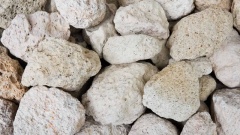Difference between revisions of "Pumice"
m |
|||
| Line 12: | Line 12: | ||
See also [[Minerals]] | See also [[Minerals]] | ||
==Application== | ==Application== | ||
| + | Pumice is widely used to make lightweight concrete or insulative low-density breeze blocks. When used as an additive for [[cement]], a fine-grained version of pumice called pozzolan is mixed with lime to form a light-weight, smooth, plaster-like concrete. <br><br> | ||
| + | It is also used as an abrasive, especially in polishes, pencil erasers, cosmetic exfoliants, and the production of stone-washed jeans. "Pumice [[stones]]" are often used in beauty salons during the pedicure process to remove dry and excess skin from the bottom of the foot as well as calluses. Finely ground pumice is added to some toothpastes and heavy-duty hand cleaners (such as Lava soap) as a mild abrasive. Pumice is also used as a growing substrate for growing horticultural crops.<br><br> | ||
| + | Grade; lump, powdered coarse, medium, fine.<br><br> | ||
| + | Use: Concrete aggregate, heat and sound insulation, filtration, finishing glass and [[plastics]], road construction, scouring preparations, [[paint]] fillers, absorbents, support for catalysts, dental abrasive, adherent for uncured [[rubber]] products, possible substitute for [[asbestos]].<br><br> | ||
| + | ==Shipment / Storage== | ||
| + | Pumice is a highly porous rock of volcanic origin. Greyish-white.<br><br> | ||
| + | For overseas carriage, consult the IMSBC Code (International Maritime Solid Bulk Cargoes Code).<br><br> | ||
| + | ==Risk factors== | ||
| + | No special hazards. This cargo is non-combustible or has a low fire-risk. | ||
| + | [[Category: Products]][[Category: Minerals and rocks]] | ||
Latest revision as of 14:58, 29 July 2014
| Infobox on Pumice | |
|---|---|
| Example of Pumice |  |
| Facts | |
| Origin | - |
| Stowage factor (in m3/t) | 1,90 to 3,25 m3/t |
| Humidity / moisture | - |
| Ventilation | No special requirements |
| Risk factors | See text |
Pumice
Description
Pumice is a textural term for a volcanic rock that is a solidified frothy lava typically created when super-heated, highly pressurized rock is violently ejected from a volcano. It can be formed when lava and water are mixed. This unusual formation is due to the simultaneous actions of rapid cooling and rapid depressurization. The depressurization creates bubbles by lowering the solubility of gases (including water and CO2) dissolved in the lava, causing the gases to rapidly exsolve (like the bubbles of CO2 that appear when a carbonated drink is opened). The simultaneous cooling and depressurization freezes the bubbles in the matrix.
Pumice is composed of highly microvesicular glass pyroclastic with very thin, translucent bubble walls of extrusive igneous rock. It is commonly, but not exclusively of silicic or felsic to intermediate in composition (e.g., rhyolitic, dacitic, andesite, pantellerite, phonolite, trachyte), but basaltic and other compositions are known. Pumice is commonly pale in colour, ranging from white, cream, blue or grey, to green-brown or black. It forms when volcanic gases exsolving from viscous magma nucleate bubbles which cannot readily decouple from the viscous magma prior to chilling to glass. Pumice is a common product of explosive eruptions (plinian and ignimbrite-forming) and commonly forms zones in upper parts of silicic lavas. Pumice has an average porosity of 90%, and initially floats on water.
See also Minerals
Application
Pumice is widely used to make lightweight concrete or insulative low-density breeze blocks. When used as an additive for cement, a fine-grained version of pumice called pozzolan is mixed with lime to form a light-weight, smooth, plaster-like concrete.
It is also used as an abrasive, especially in polishes, pencil erasers, cosmetic exfoliants, and the production of stone-washed jeans. "Pumice stones" are often used in beauty salons during the pedicure process to remove dry and excess skin from the bottom of the foot as well as calluses. Finely ground pumice is added to some toothpastes and heavy-duty hand cleaners (such as Lava soap) as a mild abrasive. Pumice is also used as a growing substrate for growing horticultural crops.
Grade; lump, powdered coarse, medium, fine.
Use: Concrete aggregate, heat and sound insulation, filtration, finishing glass and plastics, road construction, scouring preparations, paint fillers, absorbents, support for catalysts, dental abrasive, adherent for uncured rubber products, possible substitute for asbestos.
Shipment / Storage
Pumice is a highly porous rock of volcanic origin. Greyish-white.
For overseas carriage, consult the IMSBC Code (International Maritime Solid Bulk Cargoes Code).
Risk factors
No special hazards. This cargo is non-combustible or has a low fire-risk.











